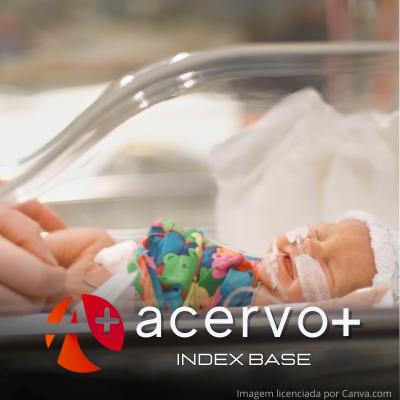Prematuridade e doenças crônicas não transmissíveis
##plugins.themes.bootstrap3.article.main##
Resumo
Objetivo: Buscar na literatura científica as evidências que associam a prematuridade às doenças crônicas dos diversos sistemas do corpo humano. Revisão bibliográfica: A prematuridade eleva o risco de doenças crônicas no futuro, a qual está relacionada à interrupção precoce do desenvolvimento intrauterino dos sistemas do corpo humano. As alterações funcionais dos órgãos e modificações endócrino-metabólicas predispõem doenças como obesidade, doenças cardiovasculares, diabetes mellitus, e síndrome metabólica. Destaca-se também a displasia broncopulmonar, em que o comprometimento da vasculatura e do desenvolvimento alveolar é causado pela imaturidade do sistema e pelo suporte invasivo neonatal. Os distúrbios cognitivos e morfológicos do sistema nervoso também são influenciados pela prematuridade, evidenciando uma maior incidência de paralisia cerebral, autismo, epilepsia e transtorno de déficit de atenção e hiperatividade. O aparelho digestivo, por sua vez, é afetado pelas mudanças da microbiota intestinal, as quais estão associadas à doenças graves como enterocolite necrosante e sepse tardia, além de aumentar o risco de asma, doenças alérgicas, anormalidades do desenvolvimento, obesidade de doenças mentais. Considerações finais: Apesar da necessidade de desenvolvimento de mais estudos, as relações entre a prematuridade e o desenvolvimento de doenças crônicas dos sistemas do corpo humano estão evidenciadas na literatura.
##plugins.themes.bootstrap3.article.details##
Copyright © | Todos os direitos reservados.
A revista detém os direitos autorais exclusivos de publicação deste artigo nos termos da lei 9610/98.
Reprodução parcial
É livre o uso de partes do texto, figuras e questionário do artigo, sendo obrigatória a citação dos autores e revista.
Reprodução total
É expressamente proibida, devendo ser autorizada pela revista.
Referências
2. CRUMP CASEY. An overview of adult health outcomes after preterm birth, early human development, 2020; 150: 105187.
3. CUNA A, et al. Dynamics of the preterm gut microbiome in health and disease, American Journal of Physiology-Gastrointestinal and Liver Physiology, 2021; 320(4): 411-G419.
4. FU Y, et al. Integration of an interpretable machine learning algorithm to identify early life risk factors of childhood obesity among preterm infants: a prospective birth cohort, BMC medicine, 2020; 18(1): 1-10.
5. GASPARRINI E, et. al. Long-term follow-up of newborns at neurological risk, Italian journal of pediatrics, 2019; 45(1): 38.
6. HEIDEMANN LA, et. al. Prevalence of metabolic syndrome-like in the follow-up of very low birth weight preterm infants and associated factors. Jornal de Pediatria, 2019; 95: 291-297.
7. HOFSTÄTTER E, et al. Introduction and feeding practices of solid food in preterm infants born in Salzburg! BMC pediatrics, 2021; 21: 1-11.
8. HOOVER J, et. al. Postmenstrual age at discharge in premature infants with and without ventilatory pattern instability, Journal of perinatology: official journal of the California Perinatal Association, 2020; 40(1): 157–162.
9. HUSTON R, et al. Early fortification of enteral feedings for infants <1250 grams birth weight receiving a human milk diet including human milk-based fortifier, Journal of Neonatal-Perinatal Medicine, 2020; 13(2): 215-221.
10. JÖUD A, et al. Associations between antenatal and perinatal risk factors and cerebral palsy: a Swedish cohort study, BMJ open, 2020; 10(8).
11. LOPES MN, et al. Dietary habits, anthropometric and metabolic profile of adolescents born prematurely. Journal of Human Growth and Development, 2020; 30(2): 241-250.
12. LOWE J, et al. Study protocol: azithromycin therapy for chronic lung disease of prematurity (AZTEC)-a randomised, placebo-controlled trial of azithromycin for the prevention of chronic lung disease of prematurity in preterm infants, BMJ open, 2020; 10(10): 041528.
13. MAKKER K, et al. Early-life determinants of childhood plasma insulin levels: implications for primordial prevention of diabetes, Pediatric research, 2023; 93(1): 189-197.
14. MASHALLY S, et. al. Late oral acetaminophen versus immediate surgical ligation in preterm infants with persistent large patent ductus arteriosus, The Journal of thoracic and cardiovascular surgery, 2018; 156(5): 1937–1944.
15. MOREAU M, et al. Neonatal and neurodevelopmental outcomes in preterm infants according to maternal body mass index: A prospective cohort study, Plos one, 2019; 14(12): 0225027.
16. MURKI S, et al. Growth and neurodevelopmental outcomes at 12 to 18 months of corrected age in preterm infants born small for gestational age. Indian Pediatrics, 2020; 57: 301-304.
17. OLDENBURG KS, et. al. Genetic and epigenetic factors and early life inflammation as predictors of neurodevelopmental outcomes, Seminars in Fetal and Neonatal Medicine, WB Saunders, 2020; 101115.
18. OU-YANG M, et al. Accelerated weight gain, prematurity, and the risk of childhood obesity: a meta-analysis and systematic review, PloS one, 2020; 15(5): 0232238.
19. PAMMI M e GAUTHAM S. Enteral lactoferrin supplementation for prevention of sepsis and necrotizing enterocolitis in preterm infants, Cochrane Database of Systematic Reviews 2020; 3.
20. PRAVIA CI e BENNY M. Long-term consequences of prematurity, Cleveland Clinic journal of medicine, 2020; 87(12): 759–767.
21. SOUTH AM., et al. Association between preterm birth and the renin− angiotensin system in adolescence: influence of sex and obesity. Journal of hypertension, 2018; 36(10): 2092-2101.
22. SOUTH AM, et. al. Obesity is Associated with Higher Blood Pressure and Higher Levels of Angiotensin II but Lower Angiotensin-(1-7) in Adolescents Born Preterm, The Journal of pediatrics, 2019; 205: 55-60.
23. SULLIVAN MC, et. al. Prematurity and cardiovascular risk at early adulthood, Child: care, health and development, 2019; 45(1): 71-78.
24. VISSERS KM, et al. The timing of initiating complementary feeding in preterm infants and its effect on overweight: a systematic review, Annals of Nutrition and Metabolism, 2018; 72(4): 307-315.
25. WESTAWAY JAF, et. al. The bacterial gut microbiome of probiotic-treated very-preterm infants: changes from admission to discharge, Pediatric research, 2021; 92(1): 142–150.
26. WILLERS M, et. al. S100A8 and S100A9 Are Important for Postnatal Development of Gut Microbiota and Immune System in Mice and Infants, Gastroenterology, 2020; 159(6): 2130–21455.

